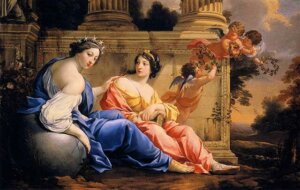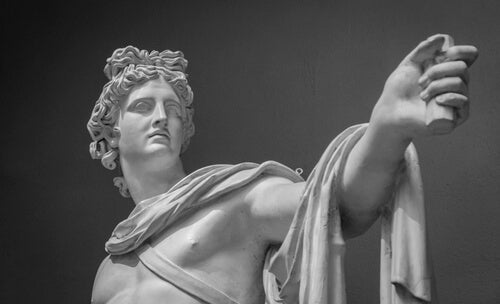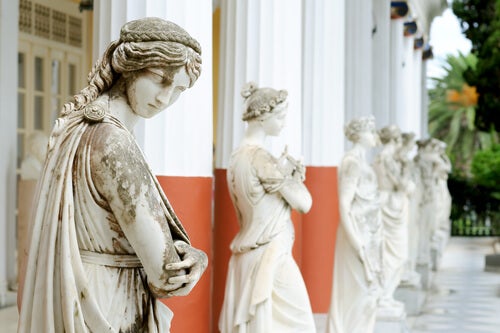The Myth of the Muses: A Source of Creative Inspiration

The myth of the muses is one of the oldest. To many, these divine beings continue to be a source of inspiration in different fields, such as arts and sciences. In fact, the word music comes from its name, as well as the word museum.
According to the different versions of the myth of the muses, they were the natural companions of Apollo, the god of music and the arts. He had romances with all the muses but at different times. This brought a huge consequence: many children.
The myth of the muses says that they were lively and festive young women who descended to Earth to whisper creative ideas in the ears of mortals. Whenever mortals listened to muses’ advice, they were then capable of producing wonderful and admirable pieces of work. However, those who never created anything.
The myth of the muses: the origins
The myth of the muses says that they were daughters of Zeus, the god of Olympus, and Mnemosyne, a titanite who represented memory. Now, the latter was the daughter of Gea, mother earth, and Uranus, who represented heaven. Some say that Mnemosyne and Zeus were together for nine nights and, for each night, a muse was born.
Mythological stories tell that, in the underworld, there was a river called Mnemosyne, which was next to another called Lete. Most mortals were invited to drink from the River Lete before reincarnating into a new being. The reason for this was that the waters of that river made them forget their previous lives and start again.
On the other hand, the myth of the muses tells that only a select few were invited to drink from the river Mnemosyne. These could remember the previous lives and became visionaries and prophets in their next incarnation.

The nine muses
Now, there are stories that speak of many different muses. However, classical history says that there were nine muses and that each one was in charge of some field of knowledge or artistic creation. According to the myth, if a creator was visited by the right muse, they would have sudden and wonderful revelations to complete their work. Here are the nine classical muses:
- Calliope or “the one with the beautiful voice”. Muse of eloquence and poetry, she wore a laurel wreath and a lyre. She was the lover of Apollo and the mother of Orpheus, Lalemo, and Reso.
- Clio or “the one that offers glory”. Muse of history. Her role was to keep alive the memory of generosity and triumphs. She had a trumpet and an open book.
- Erato or “the loving one”. Muse of lyrical-love poetry, who wore a crown of roses on her head and carried a zither. She was also the lover of Apollo and the mother of Tamiris.
- Euterpe or “the very pleasant”. Muse of music, more specifically, of the interpretation of the flute. A flower crown represented her.
- Melpomene or “the melodious”. Muse of tragedy, or rather of tragic narrative and literary writing. She dressed lavishly and wore a tragic mask.
- Polyhymnia or “the one with many hymns”. Muse of sacred songs and hymns. She was always dressed in white.
- Thalia or “the festive”. Muse of comedy and bucolic poetry. She was the hostess at banquets and festivities.
- Terpsichore or “the one that delights in dance”. Muse of dance and lyrical singing. She wore garlands and was the mother of Terpsichore, the son she had with Apollo.
- Urania or “the heavenly”. Muse of astronomy, teaching, and exact science. She carried a globe and a compass.

The presence of the muses
Although the myth of the muses was very important to the Greeks, these beings didn’t actually appear frequently in the stories of the gods. When they did, though, there were just secondary characters. Despite this, all the protagonists found inspiration in them for everything they had to do.
Some say that King Piero of Pieria had nine daughters who had great gifts for singing. Their art was so beautiful that they decided to travel where the muses lived and challenge them. Of course, the muses accepted.
When the nine young women began to sing, all the birds fell silent. Their singing was so beautiful that nature fell silent. Then, it was the turn of the muses. When they sang their songs, even the stones cried. Having won the competition, the muses decided to turn the nine young girls into magpies as a punishment for their arrogance.
The myth of the muses is one of the oldest. To many, these divine beings continue to be a source of inspiration in different fields, such as arts and sciences. In fact, the word music comes from its name, as well as the word museum.
According to the different versions of the myth of the muses, they were the natural companions of Apollo, the god of music and the arts. He had romances with all the muses but at different times. This brought a huge consequence: many children.
The myth of the muses says that they were lively and festive young women who descended to Earth to whisper creative ideas in the ears of mortals. Whenever mortals listened to muses’ advice, they were then capable of producing wonderful and admirable pieces of work. However, those who never created anything.
The myth of the muses: the origins
The myth of the muses says that they were daughters of Zeus, the god of Olympus, and Mnemosyne, a titanite who represented memory. Now, the latter was the daughter of Gea, mother earth, and Uranus, who represented heaven. Some say that Mnemosyne and Zeus were together for nine nights and, for each night, a muse was born.
Mythological stories tell that, in the underworld, there was a river called Mnemosyne, which was next to another called Lete. Most mortals were invited to drink from the River Lete before reincarnating into a new being. The reason for this was that the waters of that river made them forget their previous lives and start again.
On the other hand, the myth of the muses tells that only a select few were invited to drink from the river Mnemosyne. These could remember the previous lives and became visionaries and prophets in their next incarnation.

The nine muses
Now, there are stories that speak of many different muses. However, classical history says that there were nine muses and that each one was in charge of some field of knowledge or artistic creation. According to the myth, if a creator was visited by the right muse, they would have sudden and wonderful revelations to complete their work. Here are the nine classical muses:
- Calliope or “the one with the beautiful voice”. Muse of eloquence and poetry, she wore a laurel wreath and a lyre. She was the lover of Apollo and the mother of Orpheus, Lalemo, and Reso.
- Clio or “the one that offers glory”. Muse of history. Her role was to keep alive the memory of generosity and triumphs. She had a trumpet and an open book.
- Erato or “the loving one”. Muse of lyrical-love poetry, who wore a crown of roses on her head and carried a zither. She was also the lover of Apollo and the mother of Tamiris.
- Euterpe or “the very pleasant”. Muse of music, more specifically, of the interpretation of the flute. A flower crown represented her.
- Melpomene or “the melodious”. Muse of tragedy, or rather of tragic narrative and literary writing. She dressed lavishly and wore a tragic mask.
- Polyhymnia or “the one with many hymns”. Muse of sacred songs and hymns. She was always dressed in white.
- Thalia or “the festive”. Muse of comedy and bucolic poetry. She was the hostess at banquets and festivities.
- Terpsichore or “the one that delights in dance”. Muse of dance and lyrical singing. She wore garlands and was the mother of Terpsichore, the son she had with Apollo.
- Urania or “the heavenly”. Muse of astronomy, teaching, and exact science. She carried a globe and a compass.

The presence of the muses
Although the myth of the muses was very important to the Greeks, these beings didn’t actually appear frequently in the stories of the gods. When they did, though, there were just secondary characters. Despite this, all the protagonists found inspiration in them for everything they had to do.
Some say that King Piero of Pieria had nine daughters who had great gifts for singing. Their art was so beautiful that they decided to travel where the muses lived and challenge them. Of course, the muses accepted.
When the nine young women began to sing, all the birds fell silent. Their singing was so beautiful that nature fell silent. Then, it was the turn of the muses. When they sang their songs, even the stones cried. Having won the competition, the muses decided to turn the nine young girls into magpies as a punishment for their arrogance.
All cited sources were thoroughly reviewed by our team to ensure their quality, reliability, currency, and validity. The bibliography of this article was considered reliable and of academic or scientific accuracy.
Otto, W. F. (2005). Las musas y el origen divino del canto y del habla (Vol. 39). Siruela.
This text is provided for informational purposes only and does not replace consultation with a professional. If in doubt, consult your specialist.







